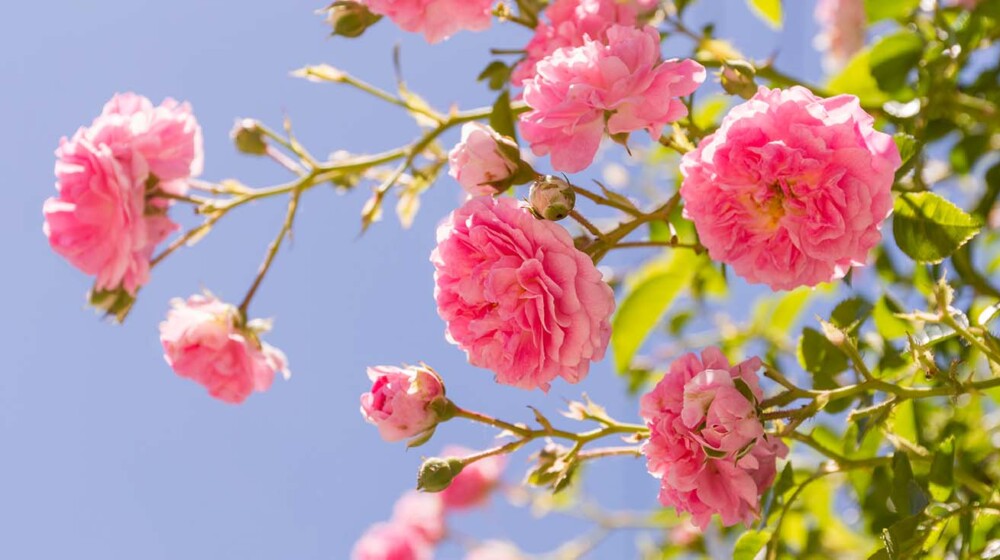“A rose by any other name would smell as sweet.”
– Romeo & Juliet (Act 2, Scene 2), by William Shakespeare
History in Bloom: Roses at Rosson House
Posted May 1, 2025
Written by Heather Roberts, Research Historian
For a printable, PDF version of this article, please click here.
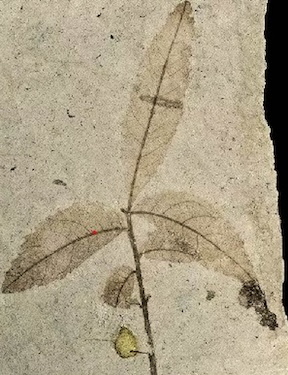
Did you know…
We have to admit, when people think of plants with thorns in Arizona, they’re usually thinking of cacti instead of roses. And they’re right! But there are about 35 species of wild roses native to parts of North America – including in Arizona – ranging from Alaska and Canada in the north, and in the south into Mexico. Fossil records show that roses are not only indigenous here, but that these beautiful flowers been around for a very long time. The oldest fossil record of a rose, dating back 35 million years, was found in our neighboring state of Colorado in 1887, in the Florissant Fossil Beds east of Colorado Springs (fossil of rosa hilliae pictured here, via Florissant Fossil Beds National Monument).
Throughout history, people have used roses in medicines, perfumes, and food. Here in North America, indiginous people have used rose hips, which are high in Vitamin C and contain substantial levels of Vitamins A and B as well, in teas or salves to treat sore throats and mouths, and also for respiratory infections. They also used rose petals in a tea to treat diarrhea, and in an eyewash to relieve red eyes.
Deliberate cultivation of roses began over 5,000 years ago in Asia, and over time people created rose hybrids – the intentional crossbreeding of rose varieties to create plants with more desirable characteristics, like longer blooming seasons, bigger blooms, disease and drought resistance, and stronger scents.
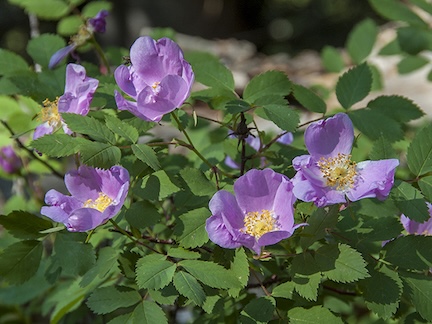
Arizona Wild Rose (Rosa woodsii var. ultramontana). Courtesy Tom Lebsack, Lady Bird Johnson Wildflower Center.
Currently, there are three categories in which all plants that belong to the Rosaceae family, under the genus rosa: Species (also known as wild, indigenous, or native roses), Old Garden (which includes heritage, heirloom, and historic roses, ), and Modern (which includes hybrid teas, floribundas, grandifloras, and climbing roses). There are 150 original species of roses, and thousands of hybrid variations.
Who brought the first non-native roses to North America is unknown, but there are records of Dutch immigrants growing flowers indigenous to Europe – including roses – as early as 1629 CE in their colony of New Amsterdam, and Franciscans brought roses to their missions in the American Southwest during the 17th century as well.
-
More Info: Rosebud Banter
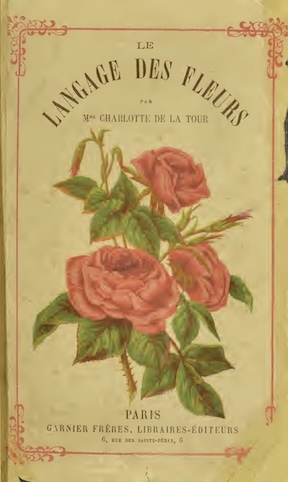
Le Langage des Fleurs, 1840 edition, written by Charlotte de la Tour.
During the Victorian Era, when “proper” behavior was more restrained, floriography – a coded language using the symbolism of flowers – was popular, allowing people to show their true feelings, even if in secret. Books were written, dedicated to the subject, like Le Langage Des Fleurs by Charlotte de La Tour, published around 1819, and The Language of Flowers, written by Kate Greenaway in 1884, but books on courtship often included the subject in their pages.
A floral “message” could be positive, like a bouquet that included shamrocks, representing lightheartedness, and vervain, which meant enchantment. But their message could also be more negative, using hydrangea, a symbol of heartlessness and boastfulness, or a carnation, that could mean refusal or disdain.
In general, roses represented love, but specific roses carried different meanings, depending on the variety, age, and/or color of the rose. For example, a white rose denoted worthiness, but a white rosebud symbolized a heart that didn’t know love, and a dried white rose told of death. Here are a few other “conversational” roses, from The Language of Flowers (version printed in 1900):
- Austrian Rose – Thou art all that is lovely
- Burgundy Rose – Unconscious beauty
- Carolina Rose – Love is dangerous
- China Rose – Beauty always new
- Christmas Rose – Relieve my anxiety
- Damask Rose – Brilliant complexion
- Dog Rose – Pleasure and pain
- Hundred-Leaved Rose – Pride; Dignity of mind
- Japan Rose – Beauty is your only attraction
- Multiflora Rose – Grace
- Single Rose – Simplicity
- White and Red Roses, together – Unity
- Yellow Rose – Jealousy
- York and Lancaster Rose – War
Browse through the book to learn more about the secret language of flowers, via Internet Archive.
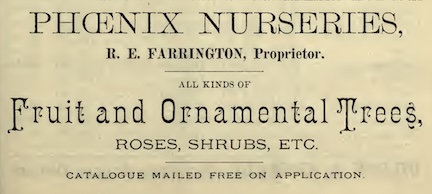
1888 Phoenix City Directory Ad
It’s also not known who brought the first cultivated roses to Arizona, but as a popular flower during the Victorian and Edwardian eras, it’s no surprise European Americans who migrated to the Arizona Territory brought their favorite roses along. One of the first was likely the Boursault rose Margaret Hunt McCormick brought with her to Prescott in 1865, and a rose propagated from a cutting of that original plant can still be seen today in the Territorial Women’s Rose Garden at Sharlot Hall Museum. About twenty years after Margaret brought her rose, cuttings from a rose variety that originated in China – the White Lady Banksia rose – was sent to Mary Gee in Tombstone, Arizona. One was planted close to a local boarding house there and grew so well in the desert heat that it’s still there – known as world’s largest rose tree!
Staying on trend, we’re also unsure who planted the first rose at Rosson House – it could have been the Rossons, who lived on the land of Block 14 for more than a decade before the house that bears their name was built, or the Goldbergs or Higleys, or even Whitelaw Reid. But thanks to an interview with Jessie Jean (Higley) Lane in 1977, we know there was a rose garden here when the Higley family lived at Rosson House, and we even know the variety of at least one of the roses that grew next to the home. Jessie Jean indicated that the rose garden was located approximately where the Burgess Carriage House and our current rose garden are, and also said they had a, “beautiful Maréchal Niel rose on a trellis…(It) climbed almost up to the second story (of Rosson House). It was just a mass of yellow blossoms.”
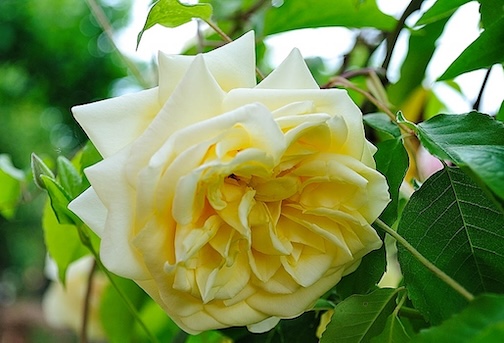
The Maréchal Niel rose (pictured here) is a historic tea rose, created in France in 1864, and is known for its prolific yellow blossoms and sweet scent, along with its ability to grow well in temperate climates like Arizona.
Local businessman T. W. Chamberlain was mentioned in the Arizona Republican newspaper in April 1902 for his Maréchal Niel rose, saying the “notable” rose covered the entire side of him home – an area of about 576 square feet! – and that was so remarkable, it had been mentioned in newspapers from three other states.
Roses did well here in Arizona, particularly with the expansion of reliable sources of irrigation in the late 19th and early 20th centuries, like the Salt River Project. City directories and tourism ads from around that time promoted the territory/state as a place where people could enjoy, “warm, sunny days in February, and roses at Christmas”. If newcomers to Phoenix hadn’t brought cuttings with them, they could order roses from catalogs like Robert Scott & Son (Philadelphia, PA), Dingee & Conard Co. (West Grove, PA), and Hill & Co. (Richmond, IN), from ads in local newspapers placed by nurseries in other states, or from local nurseries themselves.
-
More Info: Roses of the Resistance
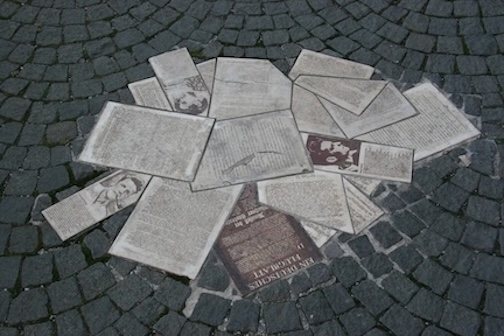 “Our current ‘state’ is the dictatorship of evil. We know that already, I hear you object, and we don’t need you to reproach us for it yet again. But, I ask you, if you know that, then why don’t you act? Why do you tolerate these rulers gradually robbing you, in public and in private, of one right after another, until one day nothing, absolutely nothing, remains but the machinery of the state, under the command of criminals and drunkards?”
“Our current ‘state’ is the dictatorship of evil. We know that already, I hear you object, and we don’t need you to reproach us for it yet again. But, I ask you, if you know that, then why don’t you act? Why do you tolerate these rulers gradually robbing you, in public and in private, of one right after another, until one day nothing, absolutely nothing, remains but the machinery of the state, under the command of criminals and drunkards?”– Third Leaflet of The White Rose resistance, Summer 1942
During World War II, a secret group called the Weiße Rose, or the White Rose, fought against fascism in Nazi Germany. Founded by students Sophie (21) and Hans Scholl (24), Christoph Probst (23), Alexander Schmorell (26), Willi Graf (25), and Traute Lafrenz (24), along with University of Munich professor, Kurt Huber (50), they printed leaflets that encouraged their fellow Germans to resist the Nazi regime. Using a typewriter and a mimeograph, they wrote six leaflets in total, and copies reached thousands of people across Germany through a covert system of supporters. Unfortunately, Sophie and her brother, Hans, were captured after distributing their last leaflet at the university. They, along with Christoph, were arrested and tried for treason at a bogus trial. All three were murdered by the Nazis on February 22, 1943. By October 1943, three of the four remaining members of the group had also been captured, found guilty of treason, and murdered. The text of the group’s last pamphlet was secretly carried to Great Britain, where the Allies reprinted it and dropped copies of the text over Germany that same year.
Today, a memorial honoring the group’s enormous courage is embedded in the pavement outside of the University of Munich in Germany (pictured here from Michael F. Schönitzer via Wikimedia Commons under CC BY 4.0).
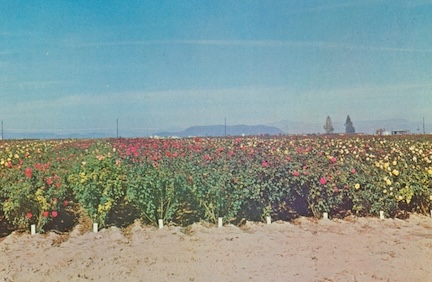
“Acres and acres of roses” in Arizona, postcard circa 1960, photo by Tom Reed.
When Japanese American farmers began cultivating land in the Phoenix area in the 1920s, they faced the challenges of clearing hard, rocky soil and toiling through intense heat, working land that many others wouldn’t. Though they were forced to abandon their farms during World War II, some returned after their unjust incarceration during the war, and reestablished themselves along Baseline Road near South Mountain. By the 1960s and 70s their fields full of flowers, including roses, had become beloved landmarks, stretching for miles – a popular place for both locals and snowbirds to visit.
In January 1958, Arizona Highways magazine featured an article about Arizona’s booming rose business, naming the state “one of the nation’s leading rose growing centers,” and estimating that Arizona produced 15 million rose plants in 1957. As many as that sounds like, today around 75% of the rose bushes sold at big box stores like Lowes, Walmart, and Home Depot are grown right here in Arizona. Our state even has a rose named in its honor – the stunning Arizona rose, a grandiflora created in 1975, with colors that reflect the vibrant shades of a desert sunset.
There are currently several rose gardens available to enjoy across the state, including the Territorial Women’s Memorial Rose Garden at Sharlot Hall Museum in Prescott, Sahuaro Ranch in Glendale, the Rose Garden at Mesa Community College, and our very own Memorial Rose Garden, planted in February 1985 and dedicated 40 years ago this month.
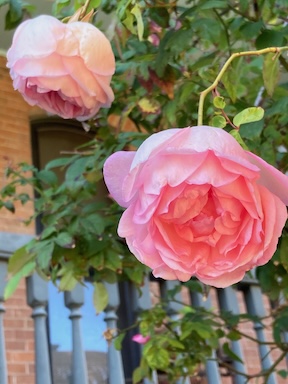 Our rose garden at The Square was planned with the help of Harpers & Berridge Nurseries and members of the Phoenix Rose Society, and designed for a charming combination of sight, smell, and touch. 114 roses were planted according to that design, and tiered with 7 taller rose trees in the middle, surrounded by hybrid tea roses, grandifloras, and floribundas, according to height. They weren’t the only roses at The Square, though – a red rose garden was planted between the Lath House Pavilion and 7th Street, and roses were planted in the front and back of Rosson House as well. Of those, only the ones in the back of Rosson House still exist.
Our rose garden at The Square was planned with the help of Harpers & Berridge Nurseries and members of the Phoenix Rose Society, and designed for a charming combination of sight, smell, and touch. 114 roses were planted according to that design, and tiered with 7 taller rose trees in the middle, surrounded by hybrid tea roses, grandifloras, and floribundas, according to height. They weren’t the only roses at The Square, though – a red rose garden was planted between the Lath House Pavilion and 7th Street, and roses were planted in the front and back of Rosson House as well. Of those, only the ones in the back of Rosson House still exist.
For the first couple of decades, the City of Phoenix maintained and watered The Square’s rose garden themselves. But when city funding was cut in 2008, the responsibility transferred to our organization, and volunteers Pat and Charlie Ihsen took over caring for the roses. They found their work cut out for them, battling weeds, pests, dead roses, and watering schedules for 11 years as the Square’s Rose Tenders. In late 2019, our newest rose volunteer, Sharon Presley, came on board and, like the Ihsens, and fought against the extreme Phoenix heat, aphids and thrip, and even damage from people – one person even stole an entire Poet’s Wife rosebush just days after it was planted!
-
More Info: An Interview with our Rose Tender
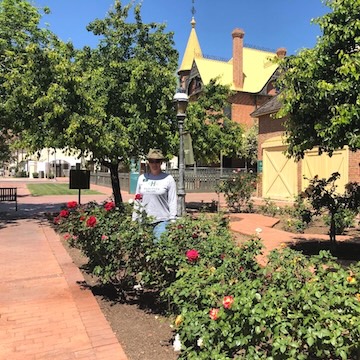 Sharon is a fantastic and very involved volunteer at The Square, who not only cares for our Memorial Rose Garden, but also helps with big events and outreach. I spoke with Sharon about rose garden for this article, and she gave me so much information, I thought I’d include some of it here.
Sharon is a fantastic and very involved volunteer at The Square, who not only cares for our Memorial Rose Garden, but also helps with big events and outreach. I spoke with Sharon about rose garden for this article, and she gave me so much information, I thought I’d include some of it here.____
When did you first start caring for roses, both in general and at The Square?
My mom loved roses. When we moved to New Mexico, I remember she kept several in a closet until it was warm enough to plant them outside. I’ve tended roses in Texas, Virginia, and Arizona.
I moved to Phoenix after retiring from the military, and was clearly not really ready to retire. I’d planned to stop by the Science Center to see if they needed a volunteer, and saw the rose garden as I walked out of the parking garage. Teiyanknei (Note: our then-Director of Operations) got an email that night asking if the Foundation needed a rose tender, but I didn’t wait for a response. The next day, November 25, 2019, she caught me weeding the garden. I saw her gesture and said to her, “Two choices, tell me to get back to work or tell me to go home.” I’ve been here ever since!
Do you have a favorite rose in the garden?
There are too many to choose from!
(Note: Though she may not recognize favorites, Sharon did mention that Lupe, the very first Rose Tender at The Square, has a favorite rose here – the Angel Face, a floribunda rose with an intense perfume and a lovely lavender color. She also mentioned that the white roses in our garden are so bright at night they almost seem to glow in the dark, the orange and peach About Face rose looks amazing at sunset, and that the pink Bewitched rose is so fragrant in the early morning, you can smell it over by Pizzeria Bianco!)
Have you seen any major changes or improvements over the years?
When I began, the garden had problems with weeds and soggy caliche. Having control over the watering system is crucial. The soil quality is improving. The Square provided a pallet and a half of soil, and a few hundred cubic feet of deodorized steer manure have been dug in in the last five years.
What techniques have you used to keep the roses healthy in the desert heat?
I put tree diapers on the rose bushes on the farthest west part of the garden – those don’t get much water from the irrigation system, if any. They keep the roots cool and evenly watered. I also spray down the roses after sunset on exceptionally hot days.
Are there any specific pests or diseases that have been particularly troublesome? How did you manage them?
Aphids and thrip are a constant problem in spring. I treat them with a combination of neem oil, lady bugs, and praying mantis.
Have there been any fun or memorable moments or events related to the garden?
Several—some may not be fit for printing! I’ve witnessed engagements (the young man asked for a rose after he forgot to bring flowers), witnessing a young widow and new widower find peace in the scent of a rose that reminded them of their sweethearts, Girl Scouts learning how to send secret messages based on the color of the flowers, families participating in ladybug release, etc. I’ve also witnessed a 12 year old run away looking for solace after life at the boy’s home got to be too much, a horribly injured and devastated young drug addict looking for safety, and a mentally impaired gentlemen streak the garden.
What advice would you give to future rose garden volunteers at The Square?
Take your time, listen to the garden. Roses will let you know if they’re happy where they’re planted. If the rose isn’t happy, move it! Also, if you have to replace a rose, look for roses that are especially heat hearty and drought resistant. There are several constraints that you’ll have to work with and around (flood irrigation system, trees, sun/shade patterns). Don’t take it personally when someone calls to complain about the scent of fertilizer in spring, or in late summer where someone always calls to complain you’re, “letting the garden die”!
If you could add anything new to The Square’s rose garden, what would it be?
I’d upgrade the irrigation system. Currently we have an old flood system. Drip lines similar to the ones at Saguaro Ranch seem to be more efficient and effective at keeping the roses evenly watered. However, budget constraints are a fact of life, and we work within them.
Are you looking for more volunteers to help you with the rose garden?
Yes! I am the youngest Rose Tender that I know of in the Phoenix area, and we need more young people getting interested in roses. Even if someone’s not an experienced rose gardener, I can teach them about dead heading, weeding without harming, and caring for the roses. It’s a great place to take a break from the world.
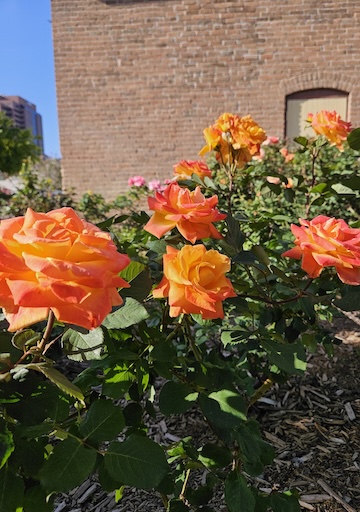
The Square’s Memorial Rose Garden, photo by visitor Claudia Sanchez, April 2025.
Today’s garden, with around 135 roses, is thriving after years of care from our wonderful volunteers. Families help with ladybug releases, Girl Scouts learn about floriography, and people find tranquility and beauty amid the hustle and bustle of downtown Phoenix. With scent and memory so inexorably mixed, it’s no wonder that roses are often used in gardens like ours, honoring and memorializing the important people in our lives with a living tribute that serves as a connection to our community and to our past.
You can browse through a few photos of some of our prettiest roses on our website here, though nothing beats seeing them in person. So, next time you visit the Square, make sure to stop and smell the roses!
Thank you to Pat and Sharon for their invaluable information about the history of The Square’s Memorial Rose Garden, and to Pat, Charlie, and Sharon for all their hard work taking care of these roses – they wouldn’t be here without you!
Learn more about gardening at the Square through our August 2022 blog article, Victory Gardens.
Browse through old seed and plant catalogs by visiting the National Agricultural Library’s Henry G. Gilbert Nursery and Seed Trade Catalog Collection, via Internet Archive.
Learn more about The White Rose resistance, and other brave Germans who fought against fascism during World War II by going to the Gedenkstätte Deutscher Widerstand (The German Resistance Memorial Center) website.
Information for this article was found in our organization’s archives, through oral interviews with Pat Ihsen and Sharon Presley, and online through World History Encyclopedia – A Brief History of the Rose; University of Missouri, Integrated Pest Management – Rose: A Brief History; Floriography: When Flowers Talk; University of Illinois Urbana-Champaign, Illinois Extension – The History of Roses; Iowa State University, Extension and Outreach – Yard and Garden: A Brief History of the Rose; The Plant Native – Native Roses: A Beginner’s Guide; American Indian Health and Diet Project – Foods Indigenous to the Western Hemisphere: Rose Hips; Native Memory Project – Wild Rose / Rosa Woodsii; American Rose Society – Rose Classifications; Rose How – Rose Categories, Modern, Old Garden, and Wild, Ultimate Guide; Smithsonian Gardens – Timeline of American Garden History; Santa Fe Botanical Garden – Origin of Roses in New Mexico; The Herald-Times (Bloomington, Indiana) – The Victorian Garden; KNAU / NPR – Earth Notes: Prescott Rose Garden; Sharlot Hall Museum (Prescott) – Rose Garden; Rose Tree Museum (Tombstone) – World’s Largest Rose Tree; Denver Botanic Gardens – The Victorian Meaning of Flowers; Cornell University Library, Online Exhibitions – Written in Petals: The Language of Flowers in Victorian Europe; The Smell of Roses – Victorian Flowers and their Meaning; Garden America – Maréchal Niel Rose; History, Art, & Archives (US House of Representatives) – Plant Patent Act of 1930; Arizona Highways (via the Arizona Memory Project) – Arizona: America’s Rose Garden of the Future; Images Arizona – Everything’s Coming Up Roses; the Glendale Star – Historic Sahuaro Ranch: Everything’s coming up roses; Zócalo Public Square – The Japanese American Flower Growers Who Made Phoenix Bloom; KJZZ Phoenix – Japanese American Family Remembers The Baseline Flower Fields; Cronkite News – Where flower fields historically grew…; the National WWII Museum – Sophie Scholl and the White Rose; The White Rose Project, Oxford University – The White Rose; Smithsonian Magazine – Hans and Sophie Scholl Were Once Hitler Youth Leaders. Why Did They Decide to Stand Up to the Nazis?.
Archive
-
2025
-
November (1)
-
October (1)
-
September (1)
-
August (1)
-
June (1)
-
May (2)
-
April (1)
-
January (1)
-
-
2024
-
December (1)
-
November (1)
-
October (1)
-
September (1)
-
August (1)
-
July (1)
-
June (1)
-
May (1)
-
April (1)
-
March (1)
-
February (1)
-
January (1)
-
-
2023
-
December (1)
-
November (1)
-
October (1)
-
September (1)
-
August (1)
-
July (1)
-
June (1)
-
May (1)
-
April (1)
-
March (1)
-
February (1)
-
January (1)
-
-
2022
-
December (1)
-
November (1)
-
October (1)
-
September (1)
-
August (1)
-
July (1)
-
June (1)
-
May (1)
-
April (1)
-
-
2021
-
December (1)
-
November (1)
-
October (1)
-
September (1)
-
August (1)
-
July (1)
-
June (1)
-
May (1)
-
April (1)
-
March (1)
-
February (1)
-
January (1)
-
-
2020
-
December (1)
-
November (1)
-
October (1)
-
September (1)
-
August (1)
-
July (1)
-
June (1)
-
May (1)
-
April (1)
-
March (1)
-
February (1)
-
January (1)
-
-
2019
-
December (1)
-
November (1)
-
October (1)
-
September (1)
-
August (1)
-
July (1)
-
June (1)
-
May (1)
-
April (1)
-
March (1)
-
February (1)
-
January (1)
-
-
2018
-
December (1)
-
November (1)
-
October (1)
-
September (1)
-
August (1)
-
July (1)
-
May (1)
-
April (1)
-
March (1)
-
February (1)
-
January (1)
-
-
2017
-
December (1)
-
November (1)
-
October (1)
-
September (1)
-
August (1)
-
July (1)
-
June (1)
-
May (1)
-
April (1)
-
March (1)
-
February (1)
-
-
2016
-
2015
-
2014
-
July (1)
-
